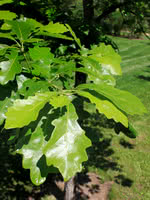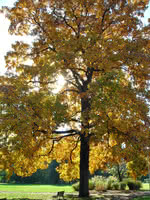Mon-Fri 9am - 5pm Mountain time
Bur Oak vs Shagbark Hickory
Quercus macrocarpa
Carya ovata
Bur Oak has a wide distribution but is one of the only oaks that will grow well on the prairies. Bur Oak produces deeply lobed, dark green leaves that turn golden yellow to brown in the fall.
Its acorns are round and half enclosed by a mossy fringed cup.
Although slower growing, this long lived tree eventually becomes a popular large ornamental tree for driveways, parks, and the front of industrial buildings. Popular as a memorial or dedication tree.
Note: Most Oak species can be considered toxic for many animals.
Shagbark Hickory is a unique tree both for its looks and uses. Its bark peels into long thin vertical strips giving it a shaggy appearance. This and its golden fall leaves make it a gorgeous looking tree. This species produces tasty hickory nuts once mature. Hickory smoke is also treasured for curing meats and its generally fantastic smell.
This tree is best planted away from any buildings due to a deep taproot and large size. Many people remark on the unusual taproot for this tree that can be over 6 feet deep while the plant only has 2 feet of top growth.

